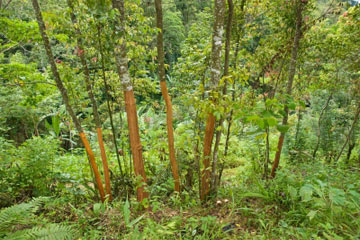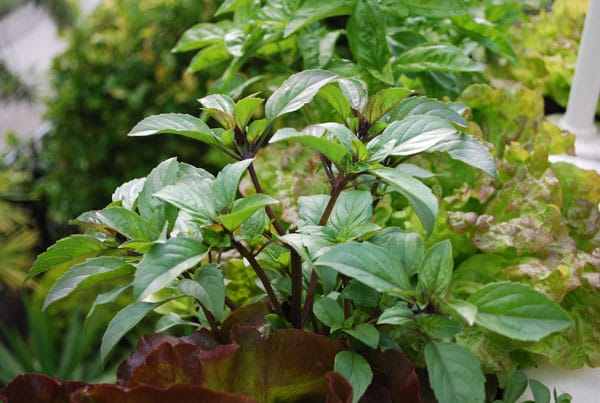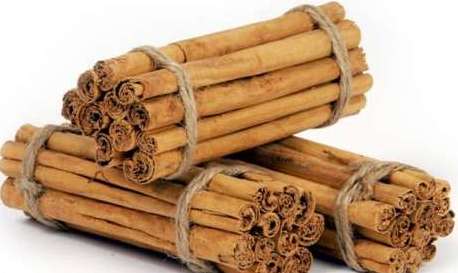A step by step guide for Cinnamon farming:
Today, we learn the farming of Cinnamon in India, Cinnamon growing conditions, Cinnamon plant care, pruning of Cinnamon plants, training of Cinnamon plants and harvesting process of Cinnamon. As you know this wonderful spice plant can be grown indoors. You can use well-drained pots for growing cinnamon at home. The climatic condition is very important for commercial Cinnamon farming.

Introduction to Cinnamon:
Cinnamon belongs to “Lauraceae” family and its botanical name is “Cinnamomum verum”. It’s also called sweet wood. Cinnamon or sweet wood is one of the oldest known spices and it’s commercially cultivated in the states of Kerala, Tamil Nadu, and Karnataka. Cinnamon is also naturally seen in the forests of the Western Ghats in India. The dried inner bark of Cinnamon is used as a spice and this tree can reach up to a height of 6 to15 meters on full growth. It has very good demand in local as well as in the international markets due to its health benefits some the cinnamon health benefits are listed below:
- Cinnamon is full of antioxidants
- Cinnamon may cut the risk of heart disease or stroke
- Cinnamon has full of anti Inflammatory Properties
- Cinnamon has a powerful anti-diabetic effect and lowers blood sugar levels
- Cinnamon spice is one of the ingredients in Indian cooking.
Indian local names of Cinnamon:
Karuvapatta (Malayalam), Dalchinachekka (Telugu), Chakke or Lavana Patte (Kannada), and दालचीनी Daalchini (Hindi and Marathi).
Commercial varieties of Cinnamon in India:
Navashree, Konkan Tej, Yercaud 1, and Nithyashree are some of the commercially cultivated species of cinnamon. Navashree variety is the best selection with high regeneration capacity (6 to 7 shoots/year), high yield (average yield 58 kg/ha in the first 4 years), and high bark recovery (41%). It has also excellent quality characters with bark oil 2.8% with a very good cinnamaldehyde content 74%, bark oleoresin 8.5%, and leaf oil 2.75%. Navashree is the best recommended and preferred type for all cinnamon-growing regions in India.
The climatic condition required for Cinnamon plantation:
Cinnamon is commercially cultivated as a rainfed crop and being a hardy plant, Cinnamon is suitable for a wide variety of climatic conditions. It thrives well at an altitude of about 1,000 m and a yearly rainfall of 200–250 cm is suitable for cinnamon cultivation. Cinnamon requires a hot and humid climate and an average temperature of 27°C are ideal for its cultivation.
Suitable Soil for Cinnamon Plantation:
Cinnamon can be grown in a wide range of soils, from organic-rich loamy soils to poor sandy loam soils. Quality of bark in cinnamon is a very important factor in its cultivation so It is better to have an organic matter in the soil for better quality production of cinnamon. Application of Farm Yard manure (FMY) can make the soil rich. Cinnamon cultivation requires well-drained soils for higher yields.
You may be interested in Taiwan Guava Farming in India.
Propagation of Cinnamon:
It is usually propagated through seed and vegetative propagation through cuttings and air layers are generally practiced in cinnamon cultivation.
The raising of Cinnamon seedlings:
In the Western Ghats, cinnamon usually flowers in January and fruits ripen from June to August. Fruits are collected from the cinnamon tree and the seeds are removed and cleaned and sown without delaying as cinnamon seeds have very less viability. Cinnamon seeds are sown in polythene bags containing a mixture of sand or in sand beds, soil and well-powdered dried cow dung in a 3:3:1 ratio. Irrigation should be done regularly and the seeds start germinating within 10–21 days. Artificial shading should be provided for the seedlings till they become 6 months old
Plantation procedure of Cinnamon
Should dig the Pits of 50 cm at a spacing of 3 meters by 3 meters. They should be filled with organic compost and-topsoil before plantation. To get the better establishment of seedlings, cinnamon should be planted from June to July to take advantage of monsoon. One-year-seedlings are planted. In each pit, 4 to 5 seedlings can be planted. The seeds are directly dibbled in pits in some cases that are filled with organic compost and soil. Partial artificial shade in the initial stages of cultivation is beneficial for the healthy and rapid growth of cinnamon plants.

Manure and Fertilizers requirement
A fertilizer dose of 20grams N, 18 grams P2O5 and 25 grams K2O/seedling is recommended for the first year. This dose is increased gradually to 200 grams N, 180 grams P2O5 and 200 grams K2O for grown-up plants of 10 years and above. Three years after planting: 29 kg of F.Y.M., 4 kg of neem cake. The fertilizers are to be applied in 2 equal split doses in May to June and September to October.
Weed Control in Cinnamon cultivation:
Two weedings in a year are required from June to July and October to November. One digging of soil around the bushes from August to September is done.
You may also check Tomato Profit Per Acre in India.
Plant care and Water requirement of Cinnamon plants:
Watering is given during summer months twice a week. The water quantity depends upon the soil moisture level and growth of plants. Cinnamon is mainly a rain fed crop. But an annual rainfall of 200 to 250 cm is preferred ideal for its cultivation.
Training and Pruning of Cinnamon Plants:
Coppicing is a method of cutting back the height of the cinnamon trees to the desired height in a commercial plantation so as to manage the plantation more effectively. 2 to 3-year-old plants are coppiced during June to July to a height of about 15 cm from the stump. Afterward, a bunch of side shoots is produced by the main stem and subsequently, the cinnamon plants assume the shape of a low bush of about 2-meter height and a bunch of canes suitable for peeling crop up in a period of about 4 years. Regular peeling operations could be carried in case of seedling bushes, from 4th or 5th year, depending upon the extent of development of peeler shoots. Normally coppicing is done in alternate years.
Harvesting procedure of Cinnamon:
The best time for harvesting shoots is from Sep to Nov. Side shoots having finger thickness and uniform brown color is ideal for bark extraction. A ‘test cut’ should be be made on the stem with a knife to make sure the suitability of time of peeling of cinnamon. If the bark separates readily, the cutting can be done immediately. The stems are cut close to the ground when they are about 2 years old, as straight as possible, 1.0 to 1.25-meter length and 1.25 cm thickness. Harvested cinnamon shoots are bundled together and transported to the pack house for further post-harvest tasks.
The yield of Cinnamon:
It depends on the type of variety and age.

For 3-4 year plants onwards: 62 to 125 kg quills/ha.
For 10 to 11 year and onwards: 225 to 300 kg quills/ha.
In addition, about 75 kg of quilling and feathering are obtained from cinnamon plants. Further, one ton of cinnamon leaves which yield 1 to 1.50 kg of oil are obtained per year.
Marketing of Cinnamon:
As this herb has many health benefits, it is very easy to market to medical companies as well as to the local markets.
That’s all folks about the farming of Cinnamon and cultivation practices. Keep growing spices and herbs!.
Some facts of growing cinnamon:
- Cinnamon can be grown indoors and outdoors
- If Cinnamon is grown indoors, it can reach up to five feet whereas in up to 24 feet outdoors
- Cinnamon leaves can reach 5 to 7 inches long
- Cinnamon bark can be harvested from branches starting from 2 years after plantation
- Cinnamon plants can be grown from cuttings
- Sri Lanka is the top producers of Cinnamon in the world
- Cinnamon can be grown in areas where there is a low altitude, moist, hot, tropical climates
- Cinnamon can be grown on pots, on the terrace, the backyard at home
- Cinnamon can be easily grown in western countries like the USA, Mexico, and Canada, etc..
You may be interested in Growing Herbs Hydroponically.
Very usefull
I would like to cultivate Cinnamon in the USA. Growing zone 10A. But I’m having difficulty finding quality plants. Where can I find Navashree?
Please email me for more details about Cinnamon cultivation
Useful information
Useful information for me
Good information, you can include some photos of plantation, matured plants, disease which we need to take care of
I WANT TO START MY CINNAMOM CULTIVATION IN MY OWN FARMS SO THAT TELL ME WHETHER COTTON SOIL IS SUITABLE FOR CINNAMOM FARMING
Is cinnamon grown in India of the Ceylon, Chinese or Indonesian varieties? This makes a big difference on the coumarin content, which has a negative impact on health.
i am very much interested in farming cinnamon, where can i get the seedling
Very useful information for beginners. I always like the way agrifarming is putting forth the information from plants introduction to marketing of the economic part. Its a boon that we have got such a nice and crisp information. I have my interest to grow. Navashree is a good cinnamomum variety. The skills required for barking is most important in its harvesting process.
Thank you Agrifarming.
I am interested to cultivate cinnamon please let me know about availability of navashree seedlings and also amount return/h